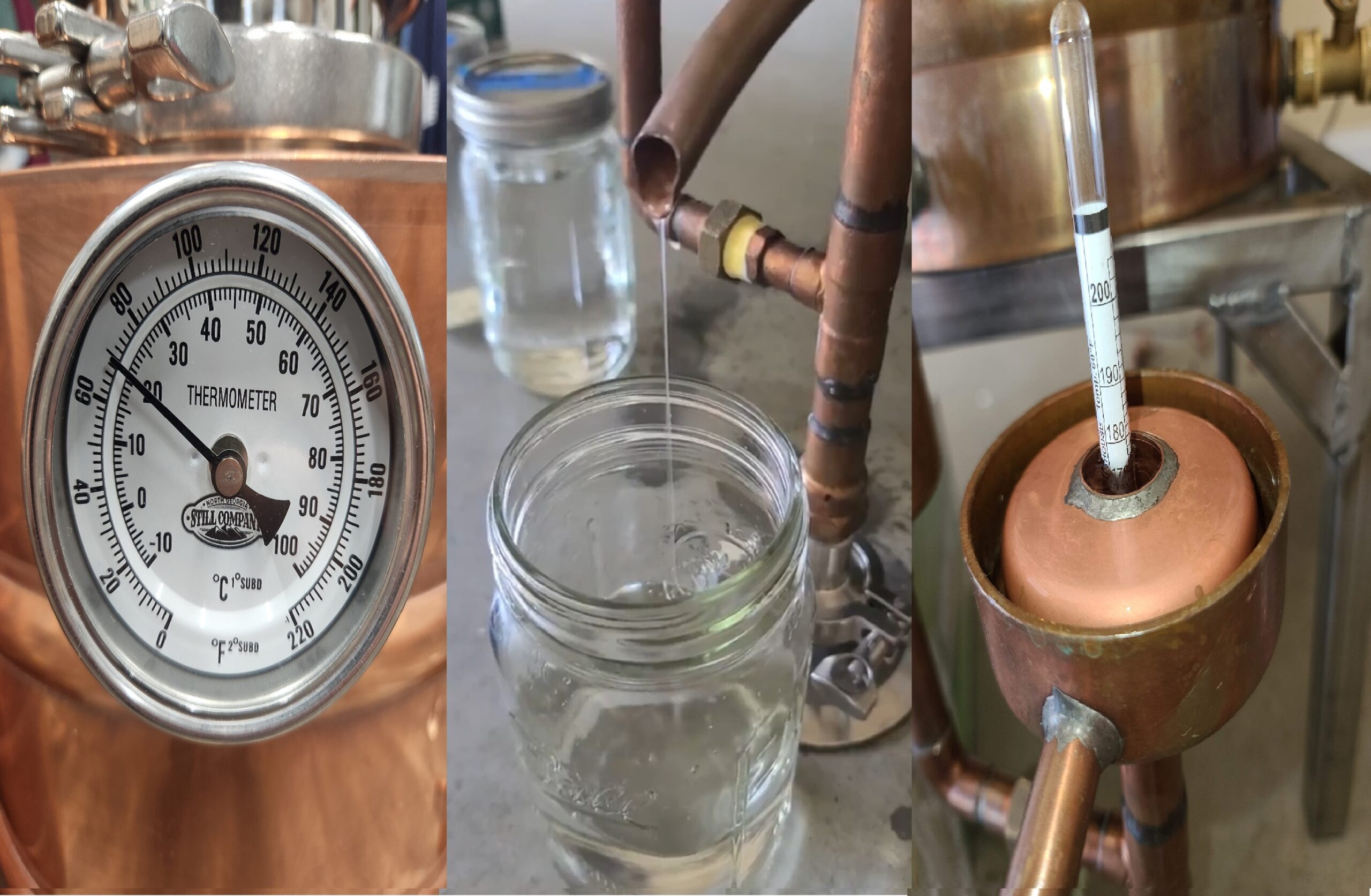Should I run my still off temperature, flow/drip rate, or proof?
Y’all ready for this one? This highly debated question has been asked over and over to ad nauseum. Rather than give a direct answer, I’ll give you some of the insights I have. For this comparison, I will be focusing on a couple different variables as examples. Those main variables will be energy input, still design, and base ABV in your mash. I plan to make a case, or dissuade you for that matter, from using these variables as a basis for each Temp, Flow, and Proof…
Temp:
First and foremost, temp. I found temperature as a benchmark to be the thing that people tend to hate the most but can’t get away from as those same people always seem to be staring at the thermometer.
Still design plays an important role in the temperature at which a still runs. If your still is designed with a thumper, you’re essentially running a sealed system, and sealed systems create pressure. Pressurizing a gas will increases its internal energy, which is often reflected in higher temperatures and pressures. Gay- Lussac’s Law states that the pressure of a gas is directionally proportional to its temperature. Essentially, the higher the pressure the higher the temp. And the higher the volume of liquid you have in your thumper, the higher the pressure needed for that gas to pass through that liquid on its way to the condenser. As a result, the temperature in the pot will be higher than that of a pot without a thumper.
Temperature can vary greatly depending on the environmental elements as well. If you’ve ever run a still outside, then you know the temperature will need to be higher in the colder months. I learned this firsthand trying to run a still with my father-in-law on a windy day. No matter what we did we couldn’t seem to get the temperature high enough for the still to produce liquor. The cool night breeze was blowing the heat away and kept the still from reaching production temp. But as soon as we set up a wind break the still immediately started to drip. The loss of heat meant we had to run the still hotter than we normally would had we been indoors.
Furthermore, energy input is not the same as temperature. I believe people think you can “turn the temperature up” when, in reality, you’re just increasing the energy input. The deeper you get into your run, the more energy that’s needed to pull the alcohol out of the wash/mash. This will be reflected in higher temperatures in the later portion of the run.
I’ve heard people say, “temperature controls the flow, so pay attention to the temperature”. Well, if that’s the case, then why can’t you just adopt a “set it and forget it” mentality? You can’t set the temperature where you want and blindly trust it will produce the desired proof. We know this to be the case since temperature isn’t constant throughout the duration of your run.
If temperature is the foremost measurement to determining where to run a still then I ask, what temperature is best? I’d say it’s hard for anyone to answer that since every still runs at different temperatures. And even the same still can run at different temperatures depending on the variables of the day.
Flow/Drip:
Flow changes throughout your run as well. The further into your run you go the slower the flow/drip rate. As a lot of us know, you need to increase the energy/heat to get the same flow the farther into your run you get. The tails take much more energy to pull off than the hearts or foreshots do.
Also, some still designs allow for a faster flow. The larger the diameter of the piping (including the lyne arm, thumper, and condenser) the less the vapor flow will be choked/throttled down. Thus increasing the flow. Additionally, the larger the pot the more alcohol that will be produced. Anyone that’s seen a large commercial still in action knows the difference in flow they can produce compared to a 5 gallon stove top still. We aren’t talking about a slow drip here. Commercial stills can be like opening a water hose full throttle. I’m sure we’ve all heard someone say that a particular still will “Piss Liquor!”
Lastly, flow can be directly linked to the amount of alcohol in the base mash. A mash with an 5% ABV will produce a much lighter flow/drip than a mash with an ABV of 15%.
Proof:
Lastly, there’s proof. To be honest, I think proof is just as bad as flow and temperature when it comes to indication during a run of the still. As you begin your distillation run, the proof will be the highest in the foreshots and heads. It gradually dips lower and lower the further along you get into your run. Also, the proof can easily change according to the energy input. If you crank up the heat, the proof can easily drop. Turn it back down, the proof can go back up.
Still design pays a role here as well. Known to reach above 190 proof, reflux stills will naturally produce higher proofs than pot stills, which in some cases may only reach a max of 150 proof on a single run.
And just like flow/drip rate, proof can also be influenced by the ABV of the mash. Having a 10% ABV mash on a stripping run will produce a much lower proof than a 40% ABV spirit run. Anyone that’s loaded their still with low wines will tell you that the proof is much higher on the second run than that of the first stripping run.
So if all of them are bad, which one is the lesser of three evils?
The problem with running your still off temperature, flow or proof is that none of these things are constant. But I haven’t found very many things in distilling that are constant.
OK, OK, OK, so I see you sitting there reading this yelling at me because I just told you temperature, drip/flow and proof are all terrible indicators to run a still on. That’s because I don’t believe that you should be using any one of these as standalone benchmarks. But rather, you should be using all of them together.
If you know your still starts to produce spirts at 190° F, well by God, take a look at the thermometer and use it as a gauge to tell you when you’re about to start producing liquor. And if you know your still likes to produce 160 proof off a 10% ABV mash, well by God, shoot for 160 proof. And if you know your still likes to “piss liquor” but want to slow it down, then maybe turn down the fire/electricity/energy input.
For me, operating a still is like driving the ‘56 Ford. I’ve got to pay attention to the clutch, gas pedal and shifter all at once for it to move smoothly down the road. Only on the still, the clutch is the temperature, the gas pedal is the flow and the shifter is the proof. You need all three for the rig to run smoothly.
Every still is different, and so is every car.
-Moonshine Shua
REFERENCES
(8) Kinetic Molecular Theory and the Ideal Gas Laws – YouTube
Column Still Distillation: How a Column Still Works | Distiller
PRESSURE AND TEMPERATURE RELATIONSHIP (theweatherprediction.com)
Column Still Distillation: How a Column Still Works | Distiller
My name is “Shua” I have been moonshining for 15 years in Texas. I co-host UN-TAXED Podcast with “Hooch” and have a deep love for distilling rum. I now, mostly, run on my electric still from North Georgia Still Company. But my first still was built from a 5 gallon stock pot with flour paste fittings. From there, I quickly moved on and cut my teeth on a homemade keg still that was initially run on flame.
Please check me out on TikTok @moonshine_shua and UN-TAXED Podcast. If you would like to see me write about something specific, please feel free to contact me at [email protected] or through social media. Thanks!
Thoughts and opinions expressed in this article are that of the author ONLY and are not representative of any business, entity or individual listed therein


Maybe I’m bias, but I love this after writing mine. Perfect Shua explanation of what I attempted to touch on. Love it brother. You taught the ol’ co-host some science as well and I love it! This digest is awesome, can’t wait for others articles!
Great information. Temperature is such a sticking point for so many people. Thermometers are great reference points once you know your still and your mash. For me flow is the main indicator, but all three definitely play an important role.